يعود تاريخ الزجاجيات في مجموعة الصباح الآثارية إلى 4500 عام، إذ تغطي المجموعة المتوفرة تقريبا فترات وحقب زمنية متنوعة. وقد ساهم تنوع الفنيات الزجاجية في المجموعة في مساعدة الباحثين والمتخصصين بلراسة وفهم وتقدير تطور تقنيات الزجاج من العصر البرونزي وحتى القرن التاسع عشر الميلادي.
سنجد هنا مثالا رائعا، من المشغولات الزجاجية ،منها وعاء أخميني عديم اللون، يعود إلى ما بين القرن السادس إلى الخامس قبل الميلاد، ويبين التصميم على شكل زهرة اللوتس والأوراق نظرة على الحرف التالية، كما ستعطينا فكرة لما ستكون عليه المشغولات الزجاجية لألف سنة أخرى.
ورث صانعو الزجاج في منطقة البحر الأبيض المتوسط والمناطق الإيرانية التابعة للحكم الإسلامي مهارات فنية وصناعية من أسلافهم، واتخذوا منحنى آخر في فترة العصور الوسطى.
في إيران، استمر قطع الزجاج على عجلات أثناء فترة العصر الساساني وحتى القران الحادي عشر الميلادي. نجت العديد من المشغولات الزجاجية والتي تم صناعتها عن طريق النفخ والتي تعود إلى الفترة المبكرة وحتى القرن الخامس عشر الميلادي. كان يتم تشكيل الزجاج عن طريق نفخه في قوالب معدنية أو خزفية لإنتاج أشكال أنيقة مع إضافة الزخرفة على السطح الخارجي.
ومنذ حوالي القرن الثالث عشر، طور صانعو الزجاج في سوريا ومصر تقنية جديدة للرسم على الأواني الزجاجية ذات اللون الواحد، وقد تم التزيين باضافة مشاهد تصويرية على المشغولات الزجاجية، وثم تطور إلى أسلوب خطي وفنون الزخرفة الكتابية، وكانت تغطي المساحات الداخلية من مصابيح المساجد والأوعية المختلفة، وغالبا ما كان يتم تذهيب السطح، وهو أسلوب لم يسبق رؤيته من قبل في الزجاج.
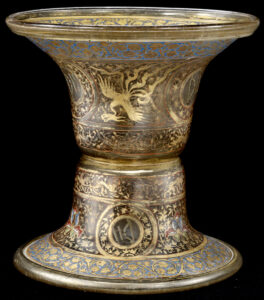
حامل من الزجاج المطلي، عليه شعار نبالة مملوكي (قوس وسهمان لبندقدار)، ورسوم لأزهار اللوتس الصينية، وطيور العنقاء، وأشرطة تصور حيوانات
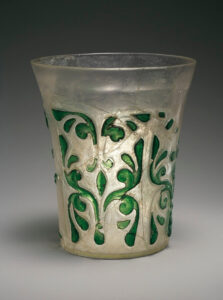
قدح زجاجي عديم اللون، نقش عليه عناصر نباتية متكررة بتقنية الحفر النافر باللون الأخضر الشفاف.
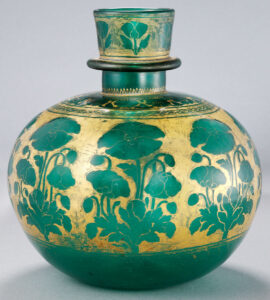
قاعدة نارجيلة من الزجاج، البدن أخضر شفاف، مزَّين بصف من نباتات الخشخاش الُمزهرة، مصطفة فوق أرضية من ذهب.
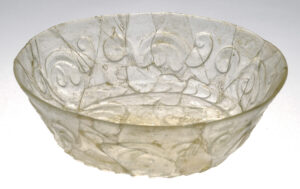
سلطانية من الزجاج. نفذ على سطحها الخارجي حفٌر بارز مشطوف لسلسلة من أنصاف مراوح نخيلية. ويظهر في القاع كائن مجنح
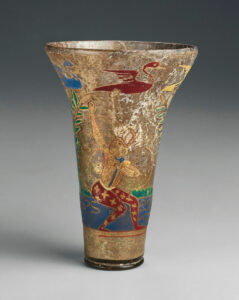
قدح من الزجاج، رسمت عليه صورة شخَصين معممين، على ما يبدو يصطادان الطيور، وسط طيور إوز طائر وخضرة محيطة بجدول
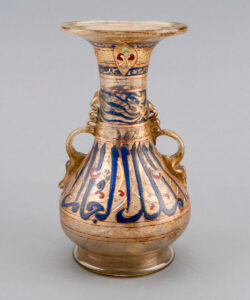
مزهرية من زجاج مغشى بالمينا عليها صورة زوج من طائر العنقاء من الطراز الصيني، ونقٌش كتابي بخط الثلث نصه: “عز
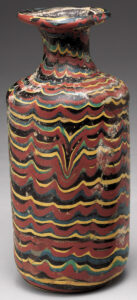
قارورة من زجاج شفاف أرجواني اللون، نقش عليها تصميم من خطوط مسحوبة باللونين الأحمر والأصفر المعتمين، والأزرق اللامع والفيروزي (والأخضر
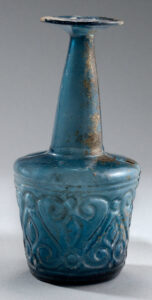
قارورة من الزجاج ذات عنق مخروطي، وحافة منفرجة.
يظهر على البدن تصميم بارز لمساحات متبادلة مثلثة، وتضم كل منها
قد يعجبك أيضًا
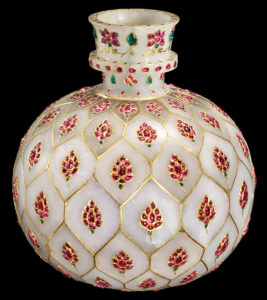
تحتوي مجموعة الصباح الآثارية على مجموعة لامثيل لها من المجوهرات والأحجار الكريمة، ولا تجسد مدى جمال القطع فقط، بل المهارات الجمالية والتقنية لأجيال من الحرفيين والفنانين.
إضافة لكونها المجموعة الأكبر والأكثر احتواءً على المجوهرات الإسلامية في العصور الوسطى على مستوى
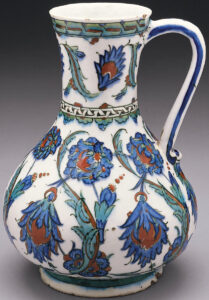
يعتبر السيراميك من أقدم المواد التي تم استخدامها في الصناعات والحرف، حيث يعود تاريخها إلى العصر الحجري القديم، أي منذ أكثر من ثلاثين ألف عام. تضم مجموعة الصباح الآثارية فنيًات متنوعة من السيراميك، والتي تركزت على تجميع هذه التحف الفنية
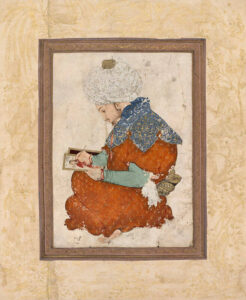
تحتوي مجموعة الصباح على عدد وفير من مخطوطات القرآن الكريم، والتي تضم صفحات مزدوجة لواحدة من أقدم المخطوطات القرآنية المعروفة، والتي تم نسخها في القرن الثاني بخط رأسي مميز يعرف باسم “الحجازي”، إضافة إلى مخطوطة كبيرة الحجم، مزينة بشكل رائع،